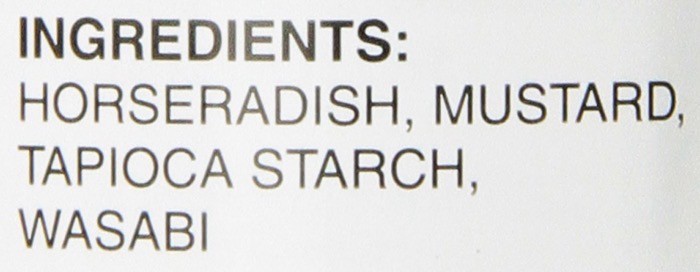So let's talk about wasabi, you know… that green stuff that's always served alongside your sushi. You either love it or hate it and if you hate it, you're probably not reading this anyway, but is it keto friendly?
Wasabi is a very low carb condiment that is ok to consume while following a keto diet. Wasabi root, wasabi paste, and wasabi powder have one net carb per teaspoon. A little wasabi goes a long way, whether enjoying alongside sushi or used as part of a recipe.
Nothing goes better with some sushi or sashimi than a bit of soy sauce mixed with a little wasabi.
In this article, I'll discuss the difference between the different types of wasabi, how many carbs wasabi has, any health benefits, and a little deeper into exactly what the mysterious green stuff is.

Table of Contents
Can You Eat Wasabi On Keto?
Funny story, well, not amusing depending on who you ask, I suppose.
I have a nephew who would always come out with us when we ate sushi, and my nephew's favorite part of the meal was dessert. My nephew LOVES green tea mochi ice cream.
Anyway, when my nephew was about 7-years old, and we were out and about eating at a sushi restaurant (you may know where this is going already), we had been served this big ball of wasabi on a little plate. Before any of us could say anything, he had grabbed the ball of wasabi and took a large bite out of it thinking it was mochi ice cream.
Let's say that a piercing scream and lots of tears followed shortly after, poor guy.
Anyway, he's well into college now and remembers that fateful evening.
But I digress…
Wasabi, can you eat it on keto? Wasabi is quite low in carbohydrates, and chances are you're eating a tiny portion at that.
A little does go a long way with wasabi.You can most certainly have wasabi while on a ketogenic diet.
Is Wasabi Paste Keto Friendly?
Wasabi paste can mean different things to different people, so let's first distinguish the differences between the different types of wasabi.
In general, there are three major types of wasabi you'll come across, and those are:
- Wasabi root
- Wasabi paste
- Wasabi powder
Wasabi root
The most traditional of wasabi is freshly grated straight from the root (it doesn't come from a tube). The chances are that if you're not eating in a high-end sushi restaurant or grating it yourself, and by high-end, I mean $$$$ high-end.
The reality is, you're likely getting one of the latter two varieties of wasabi.
Real wasabi japonica (Japanese horseradish) is quite rare, and if you're able to find some, it's also costly.
We're talking $100/lb as an average cost if you can even find any.
Wasabi paste
Sorry to burst your bubble, but most wasabi paste is also fake. Over 95% of the wasabi served at sushi restaurants does not contain any real wasabi or minimal amounts of it.

Most wasabi you'll find at the sushi restaurant or grocery store is a blend of horseradish, mustard powder, various spices, and food coloring.
You'll notice that the tubes may say “with real wasabi,” because there is SOME real wasabi mixed in, but the majority of it is horseradish and other fillers.
Real wasabi paste in a tube would likely need to be special ordered and come frozen.
Wasabi powder
Wasabi powder may be the easiest and cheapest way to source some real wasabi, though most store-bought wasabi powder is also fake.
Wasabi powder is used by mixing a little water to make a paste.
If you want the real stuff, I would recommend this brand, which is 100% wasabi japonica.
Similar to most wasabi paste, most wasabi powder is not actual wasabi, but a blend of horseradish, mustard, and tapioca flour.
Does Wasabi Have Carbs Or Contain Sugar?
You'll be glad to know that wasabi, even the “fake” kind has minimal carbohydrates.
A one teaspoon serving of any of the three varieties (fresh, paste, or powder) will only have one net carb per teaspoon (2g) serving.As far as I know, whether you purchase the paste or powder, or have wasabi from a sushi restaurant, I have yet to see any wasabi have any added sugar. The most sugar you'll get when eating sushi will likely come from the pickled ginger they serve alongside.
Therefore, don't worry so much about the carbohydrates that come from wasabi.
I imagine you won't be using much wasabi, so chances are you'll be getting very little carbohydrates relative to the amount you would use, even if you use a lot of wasabi like myself.
Is Wasabi Healthy?
Wasabi is rich in a compound called isothiocyanate (ITC), which is responsible for the pungent flavor of the spicy green stuff we all know and love.
While the research isn't at a point where you should be running out and consuming mass quantities, the potential benefit may be worth it for some to spring for the real stuff.
It's the ITCs in wasabi that is responsible for many of the researched health benefits, which are listed below.
Anti-inflammatory
Although human studies are lacking, the ITCs in wasabi have been found to suppress cells and enzymes that promote inflammation in animal cells. 1 2
Anti-bacterial
Wasabi extract has been shown to have antibacterial effects against the two most common bacteria that cause food poisoning, E. Coli and Staphylococcus aureus 3
This means that wasabi extract may offer the ability to reduce or prevent the risk of foodborne illnesses.
May help prevent weight gain
The leaves of the wasabi plant contain compounds that may prevent or hinder the growth of fat cells. 4
Anti-cancer properties
Test-tube studies indicate that the ITCs, like those found in wasabi, may help inhibit or kill the growth of breast cancer, pancreatic, and colorectal cancer cells. 5 6 7
What Is Wasabi?
So what exactly is wasabi? Wasabi is a plant that is part of the mustard family, referred to as wasabi japonica (aka Japanese horseradish),
Wasabi is in the same Brassicaceae family as horseradish, which also includes radish, cauliflower, broccoli, and cabbage.
Real wasabi paste is made by grating the root of this plant, though other parts are also edible.
Once the root is grated, the compounds that give wasabi its distinct taste begin to break down within minutes. This, along with the expensive nature of wasabi, and that fact that it's hard to grow is what makes finding real wasabi hard to come by.
That's why any real wasabi paste would likely come frozen, to preserve its flavor and real high-end sushi restaurants will probably grate the wasabi shortly before serving.
Keto-Friendly Ideas And Recipes For Wasabi
If you're looking for ways to insert a little spice into your keto life, wasabi can be used for more than just sushi.
Here are a few ideas you may want to give a try.
- Guacamole: adding a teaspoon of wasabi to your guacamole will give it a nice unexpected “kick.”
- Wasabi jalapeno sauce: Try this delicious recipe from Allrecipes.
- Deviled eggs: Another great recipe using wasabi courtesy of Allrecipes.
- Wasabi mayo: combine a cup of your favorite mayo with 1/2 tbsp of wasabi paste or powder. This goes well with salmon and roast beef.
- Wasabi almonds: Want an easy way to make some fancy “craft” almonds? Try this yummy recipe from Ketohh.
The Takeaway
If you love having that pungent and spicy green paste known as wasabi, then dig right in, because it's quite low in carbohydrates and very keto-friendly.
Just remember, the likelihood of you getting real wasabi is very slim at your local sushi joint, and even most store-bought pastes and powders are made from horseradish with other ingredients.
If you've never tried real wasabi, I'd highly suggest you try it for yourself at least once in your life!
